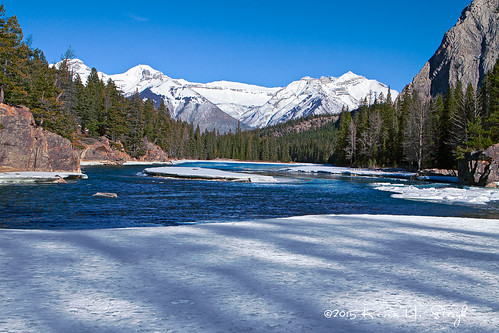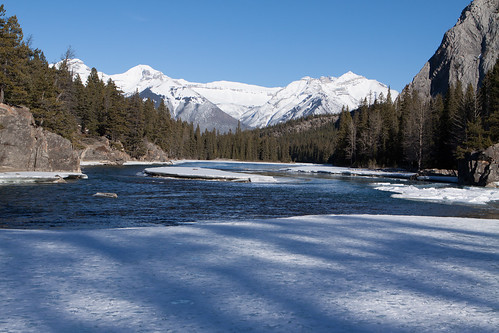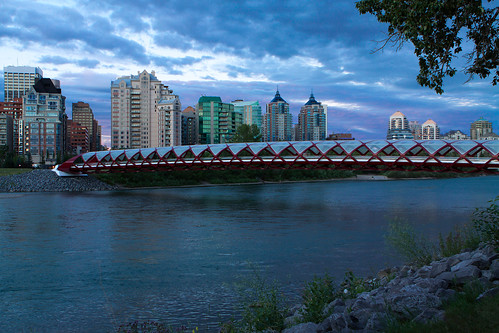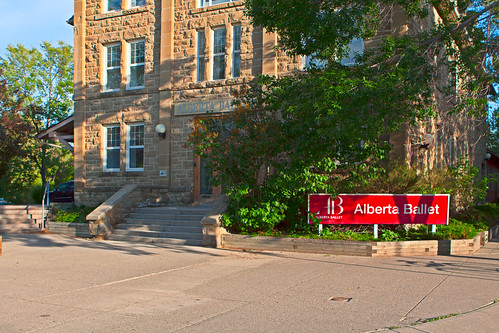
I took the above picture near Bow Falls, within the town of Banff, in Banff National Park, Alberta. And below, is the same picture but straight out of the camera. As you can see, I enhanced the colors. You can click on either photo to be taken to a larger version at Flickr.

By being a beta-reader, I am helping Dan Margulis, a friend and a best-selling author, write a new book on Photoshop. I, along with 13 others, am proof-reading his text, making sure that everything flows, the discussion and examples can be readily followed, and, we hope, there are no typos.
For those that are unfamiliar with Dan, he has already written several highly acclaimed Photoshop books, including: Professional Photoshop: The Classic Guide to Color Correction (5th Edition); Photoshop LAB Color: The Canyon Conundrum and Other Adventures in the Most Powerful Colorspace; and Modern Photoshop Color Workflow The Quartertone Quandary, the PPW, and Other Ideas for Speedy Image Enhancement (Amazon affiliate links). We are working on a follow-up or revised edition to his Canyon Conundrum book.
Although I am strictly an amateur photographer who enjoys working with Photoshop, I have read Margulis’s books, which many readers consider difficult but worthwhile, and have taken two of his courses. That said, to become extremely good at photography and Photoshop, one needs to gain considerable experience with each. I am improving, slowly but surely. Every time I take a new photograph and process it through Photoshop, I learn something new.
To keep learning, I am observant and willing to experiment. As mentioned in my photography articles, I compare my results to what I had envisioned. That usually helps to spot mistakes quickly. And, I am willing to try different techniques or methods, both in photography and Photoshop.
Returning to Dan’s book, the beta-reading exercise is a challenging but rewarding endeavor. The challenge is to understand everything and that takes some effort. I have had to read some parts two or three times. Because of my limited experience and proficiency, I might be working harder than others in our group. That said, we each fill a certain demographic of Dan’s expected readership, so I am helping to fulfill the serious amateur role. Moreover, each of us works independently to provide feedback. As I have commented to others, being a beta-reader is much like being a student taking a graduate level course—it takes a lot of hard work and effort. The great news is that it is rewarding because I have the opportunity to gain more insights and experience.
As you’ve seen from a prior post, on February 23, I went out to Banff to take photographs. My favorite photograph from that day is the one at the top of this article. The most difficult challenge I had in retouching it in Photoshop was the blue shadows on the ice immediately in front of the camera. I deliberately brought out color variation from the trees and the rocks, but that move also intensified the blue shadow, so much so that it looked garish in my first iteration. One of the unfortunate aspects of working for a while in Photoshop is that you become inured to overly strong colors. Soon, they begin to look proper and normal. It’s only when you step away for a while or someone else comments on your photograph that you begin to see the problem.
In this case, I was unsure how to treat the overly blue shadow. Dan has an online Color Theory Group where other enthusiasts can exchange information. I posted my dilemma and asked for help. Another enthusiast Les De Moss came to my rescue. He just happens to be a former beta-reader for Dan’s books, just happens to own a color lab, and just happens to live in the Rockies. He provided a sample file where he showed how to split the file into parts and treat each separately. So everything but the ice was one part, which I already had completed, and the ice with the blue shadows was the second part. Once I knew how to treat the ice, I didn’t take long to finish both parts and recombine them.
All that said, I am happy with my final result. You, of course, will have to form your own opinion.
Every exercise increases my learning and experience. In this instance, I learned how to work with blue shadows on white snow and how to separate and recombine parts of a photograph. The other positive aspect of this type of learning experience is helping and receiving help from others—a little help from my friends.




Recent Comments